| Article ID | Journal | Published Year | Pages | File Type |
|---|---|---|---|---|
| 1478570 | Journal of the European Ceramic Society | 2006 | 8 Pages |
The formation of intragranular pores, induced by diopside crystallization in diopside–albite glasses, was highlighted in a previous study and here confirmed by SEM observation. The sinter-crystallization kinetics of four glass compositions, labelled G1, G2, G3 and G2-Cr, characterized by the formation of induced crystallisation porosity, PCR, was investigated. The activation energies of crystallisation, EC, and sintering, ES, were evaluated by differential thermal analysis (DTA) and by contact differential dilatometer in non-isothermal conditions, respectively.The results highlighted that the kinetics of the crystallization process was not influenced by the PCR formation and that the EC values are in agreement with the corresponding activation energies of viscous flow.The sintering was evaluated up to 24% linear shrinkage of the samples. In the initial stage of the densification, up to 8% shrinkage, the measured ES values are comparable for all glasses while, between 9 and 24% shrinkage, ES increase as a function of the crystallisation ability of each glass. Bulk nucleation occurred in G2-Cr: the rate of phase formation resulted to be higher, the densification was inhibited by the formation of 6 ± 3 wt.% diopside and significant open porosity remained in the sintered glass-ceramic.
